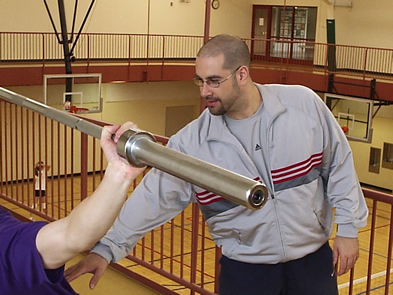Speed and Agility Training With Young Athletes
A lot of people in this field call themselves Strength & Conditioning Coaches. I don’t have a problem with the “Strength” part of the title, but the “Conditioning” part could use a little work.
As a former college S & C Coach, I fully understand the time constraints of the collegiate or high school environment. Running a private facility for athletes, I also understand the limitations of this situation. In both cases, it is very difficult to give every athlete the time and instruction they need. Still, there is one area of our profession that I feel is in desperate need of some attention. That area is what I call Movement Training.

Recently, I was asked by a college coach what mistakes I have made in the past and what I would do differently if I could re-live the past 6-10 years of my career. At first, like many coaches, my ego didn’t want to admit to any mistakes, especially to another coach. But, after some thought, I realized that the area in which I have the greatest impact on athletes today, I simply did not understand when I was younger.
A few years ago, I thought the best S & C Coach was the one who most fully brutalized his/her athletes. I thought I was supposed to lift my athletes until they puked and condition them until they couldn’t see straight. Don’t get me wrong, I still think that stuff has its place. I love putting athletes through brutally hard workouts, and I think that kind of hard work can have amazing benefits (it also has terrific entertainment value). But, through time, I have gained a better understanding of how to maximize the “Conditioning” or “Speed and Agility Training” part of my job title.
To a lot of coaches, conditioning means creating running programs that enhance the physiological processes involved in aerobic or anaerobic metabolism. You may not think of it this way, but that is essentially what many conditioning programs are designed to do. I have no problem with this. Conditioning sport-specific energy systems is a vital part of athletic success.

Many coaches also implement speed, agility, and plyometric routines into their programs, and I think it’s great to see coaches making an effort to improve the physical abilities of their athletes. Unfortunately, I see way too many mistakes being made in this area, and I think many coaches are doing their athletes an injustice.
Over the years, we have read articles by some great coaches about specificity, but the full message of these wise men is often lost in an effort to use their message to support our own views. I’m sure you’ve done it. You’ve read an article, and thought to yourself “That’s what I’m talkin’ about. That’s why I do what I do. I’m going to use this article to support my speed and agility training philosophy.”
The articles have been great. They have helped a generation of S & C Coaches formulate their strength training philosophies….strength training philosophies. Why didn’t we see that the same information we’ve applied to strength training can also be used to develop effective speed and agility programs?
In my opinion, a lot of S & C Coaches approach speed and agility training the same way they approach strength training.
They find out what other coaches are doing (through reading summer manuals, watching workouts, etc.), and duplicate it in their environments. This has worked out pretty well for strength training because there are a lot of good Strength and Conditioning Coaches to learn from.
Unfortunately, there are a few problems with learning about speed and agility training this way.
First, there are not nearly as many quality speed and agility coaches to learn from.
Second, most of us didn’t learn anything about effective movement patterns in school.
Third, proper coaching of speed and agility training for young athletes is highly dependent on coaching prowess, movement analysis, and the ability to understand proper movement patterns. It is more like teaching a sport skill; instructor knowledge is vital, and you can’t just apply a cookie-cutter approach like many coaches do with strength training. Nonetheless, we’ve learned our speed and agility drills from Strength Coaches not Speed and Agility coaches.
The best case scenario for many of us was to learn a few drills from a track coach or catch an article outlining a couple of exercises. This kind of coaching just doesn’t cut it. I believe that movement training falls under the “Conditioning” part of our job title, and it’s time we take full responsibility for this important part of our jobs.
I like to call speed and agility training “movement training” because the goal is to train athletes how to move more efficiently. The problem with most movement training is the assumption that if we put some cones or hurdles out in a cool design and have our athletes run through them, we are making an impact on their movement patterns.

The truth is, we’re not. All we’re doing is helping them reinforce whatever movement patterns they are using to get through the drill. Take a few minutes to re-read some of those specificity articles, and I think you’ll see exactly what I’m talking about.
I have had the good fortune of working with, observing, and learning from a lot of good sport coaches and instructors. I have never seen a good basketball coach allow players to take hundreds of jump shots with poor shooting technique, and I have never seen a good baseball coach let players pitch and hit with poor mechanics. Unfortunately, I have seen a lot of Strength Coaches allow athletes to perform hours of agility drills using horrible technique.
A lot of coaches assume that if the athletes are going through the drills, their athleticism will improve. But, the benefits of performing speed and agility drills are dramatically reduced if the athletes are not executing them with sound mechanics and learning proper technique. If the coach is unable to analyze the movement and give corrective feedback, what good is he/she doing for the athletes?
There are still a lot of questions about speed and agility training and movement training especially with young athletes, but there are certainly some answers and a lot of room for us to improve. I look forward to examining this misunderstood aspect of our profession in more detail with you in the future.
Looking for agility drills to increase speed?
Download this free video and get access to 15 Free drills.







